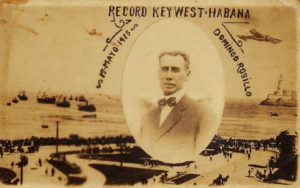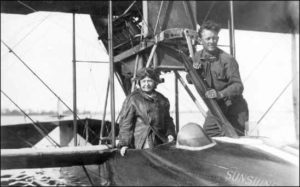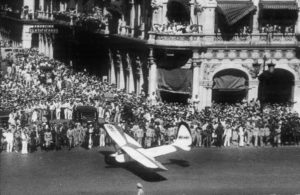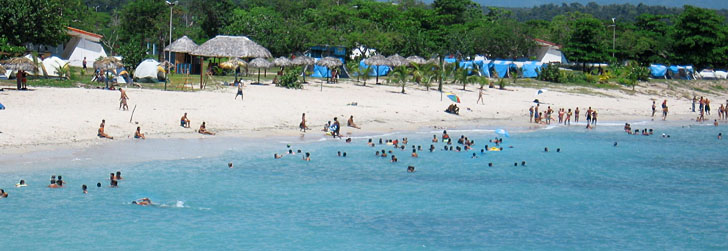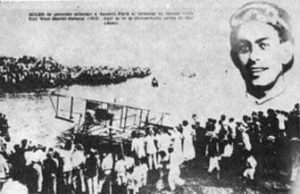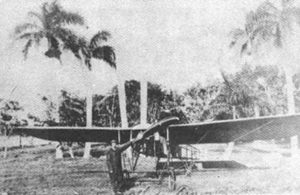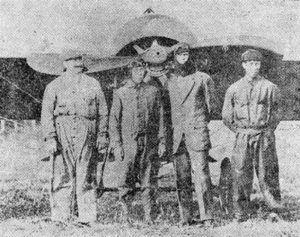On May 17, 1913, Domingo Rosillo and Augustin Parlá, pioneers of Cuban aviation, added their names to the history of aviation, by making the first international flight of aviation in Latin America. They established a world-wide distance record by flying their airplanes the 90 miles from Key West to Havana in 2 hours and 40 minutes. This record was snatched from nobody less than the famous French pilot and aeronautical designer, Luis Bleriot.
The aerial trip between Key West in the U.S.A. and Havana was considered to be extremely dangerous. North American aviator McCurdy had tried it without success in 1913 and the two Cubans would repeat his attempt in the hope of better luck. The City Council of Havana decided to reward the feat: “Ten thousand pesos for whoever arrives first and five thousand for the second” Domingo Rosillo
The flight would depend on the support of three ships of the Cuban Navy: the “Patria”, which would be stationed at 45 miles from Havana, the “Hatuey” at 30 miles, and the “24 de Febrero” at 15 miles from the finish. A North American ship: the Auxiliary Gunboat “Peoria” also would cooperate to insure the security of the intrepid pilots.
When the first airplane took off from Havana, the battery of La Cabaña would fire two cannon shots to announce the start of the passage.
Nevertheless, the day of departure had not yet arrived. Rosillo had gone to Key West before Parlá and had it not been that the propeller of his Bleriot-XI monoplane had been broken during a test flight, one he made to please the Cuban immigrants who longed for a triumph, the flight would already have been attempted. He had to wait until a replacement propeller could arrive from Cuba. Parlá arrived in Key West in his Curtiss hydroplane, which was powered by an engine of 80 horsepower.
Parlá, in spite of his lack of experience, had the superiority of his apparatus to make a flight over the water in his favor. If it had to land unexpectedly on the ocean, at least it would be able to float.
Anyway, Rosillo’s propeller was delayed even longer and although Parlá was ready for the flight, the conditions at the time were not favorable. It was known that Rosillo would bring a letter valise with him and an order to buy tobacco at the Gato factory. The tobacco industry would thus use aviation for its commercial operations for the first time.
At the first light of dawn of that day, on the smallest of three signal masts of the Morro de La Habana, a red flag appeared: the public knew that it was the great day. At 5:10 a.m., Rosillo departed. His airplane was baptized with the name of “Habana” and on the rudder was written, “Cuba”. He flew for 2 hours, 30 minutes and 40 seconds. At that point, he ran out of gas. A strong crosswind had made him consume more fuel than he had anticipated.
“I began to see that the gasoline level was dropping in the indicating tube, at a rate faster than had been calculated. All around I could only see sea and sky. The machine performed perfectly; I saw the “Hatuey”, and passed it. The tank was almost empty, but finally I saw Cuba. I had arrived without a drop of gasoline in the tank. I couldn’t even make it to where I had planned to land, in the Polígono de Columbia. I had to land instead in el campo de tiro. The wind had made me use more fuel than I had planned. I had filled the tank with 50 liters, and on a lucky hunch, I had added 10 ounces more… ”
Parlá, on the other hand, had left at 5:57 and by 6:01 he had to return: “I began the flight, but the apparatus did not respond properly. It would not let me compensate for the wind that blew. When I returned and inspected it, I found that two tension wires of the elevator were broken.” Rosillo was, without a doubt, the winner.
On the 19th, at 2:00 in the afternoon and without previous notification of his intentions, Parlá again went in search of his goal. He did not have support from the Navy. Unlike Rosillo, who preferred to fly escorted by ships, Parlá flew on his own. The news came as a surprise in Havana and the public prepared to receive the resolute aviatior. More than two hours had passed, still the Curtiss was not seen from el Morro. Had he perished? Was he floating somewhere of the Caribbean? Had he been blown off course by the wind, to who knows what place, and now he would fly without directions? everyone asked.
Agustin Parlá al concluir su famoso vuelo Cayo Hueso- Mariel-La Habana. Miles de personas lo reciben en la antigua caleta de San Lázaro, hoy Parque “Antonio Maceo”
Soon the answer arrived: “aviator Augustin Parlá landed on the water in the bay of Mariel, at the risk of his life, at 4:30 today, May 19, 1913. Motor failure had prevented him from reaching Havana, but he is well and already has started off by automobile for the capital “.
Of the flight from Key West a reporter wrote, “… filled with limitless patriotism and a tenacious resolution, he embarked on the trial flight. As the town had followed it from start to finish, they finally learned that the aviator had moved steadily along the ideal course, the one that led to Cuba “.
The City Council of Havana awarded the second prize to Parlá, although, in truth, it was Cuba who won, as was affirmed: “its name is registered in the history of aviation and will be placed among the advanced countries due to their persistence to advance aviation up to the maximum limit”.
EL AUDAZ VUELO KEY WEST-HAVANA DE LOS PIONEROS CUBANOS.
El 17 de mayo de 1913, Domingo Rosillo y Augustin Parlá, pioneros de la aviación cubana, agregaron sus nombres a la historia de la aviación al realizar el primer vuelo internacional de aviación en América Latina. Establecieron un récord de distancia mundial volando sus aviones a 90 millas desde Key West hasta La Habana en 2 horas y 40 minutos. Este disco fue robado a nadie menos que el famoso piloto francés y diseñador aeronáutico, Luis Bleriot.
El viaje aéreo entre Cayo Hueso en los Estados Unidos y La Habana fue considerado extremadamente peligroso. El aviador norteamericano McCurdy lo había intentado sin éxito en 1913 y los dos cubanos repetirían su intento con la esperanza de tener más suerte. El Ayuntamiento de La Habana decidió premiar la hazaña: “Diez mil pesos para quien llega primero y cinco mil para el segundo” Domingo Rosillo
El vuelo dependería del apoyo de tres barcos de la Armada cubana: la “Patria”, que estaría estacionada a 45 millas de La Habana, la “Hatuey” a 30 millas, y la “24 de Febrero” a 15 millas del terminar. Un barco norteamericano: la cañonera auxiliar “Peoria” también cooperaría para garantizar la seguridad de los intrépidos pilotos.
Cuando el primer avión despegó de La Habana, la batería de La Cabaña dispararía dos cañonazos para anunciar el inicio del paso.
Sin embargo, el día de la partida aún no había llegado. Rosillo había ido a Cayo Hueso antes de Parlá y si no hubiera sido porque la hélice de su monoplano Bleriot-XI se había roto durante un vuelo de prueba, una que hizo para complacer a los inmigrantes cubanos que anhelaban un triunfo, el vuelo ya habría sido intentó. Tuvo que esperar hasta que pudiera llegar una hélice de repuesto desde Cuba. Parlá llegó a Cayo Hueso con su hidroavión Curtiss, que funcionaba con un motor de 80 caballos de fuerza.
Parlá, a pesar de su falta de experiencia, tenía la superioridad de su aparato para hacer un vuelo sobre el agua a su favor. Si tuviera que aterrizar inesperadamente en el océano, al menos podría flotar.
De todos modos, la hélice de Rosillo se retrasó aún más y aunque Parlá estaba listo para el vuelo, las condiciones en ese momento no eran favorables. Se sabía que Rosillo traería una valija con él y una orden para comprar tabaco en la fábrica de Gato. Por lo tanto, la industria tabacalera usaría la aviación para sus operaciones comerciales por primera vez.
A la primera luz del amanecer de ese día, en el más pequeño de los tres mástiles del Morro de La Habana, apareció una bandera roja: el público sabía que era el gran día. A las 5:10 a.m., Rosillo se fue. Su avión fue bautizado con el nombre de “Habana” y en el timón fue escrito, “Cuba”. Voló durante 2 horas, 30 minutos y 40 segundos. En ese punto, se quedó sin gasolina. Un fuerte viento cruzado lo había hecho consumir más combustible de lo que había anticipado.
“Empecé a ver que el nivel de gasolina caía en el tubo indicador, a un ritmo más rápido de lo que se había calculado. A mi alrededor solo podía ver el mar y el cielo. La máquina funcionaba perfectamente, vi el” Hatuey “y lo pasé. El tanque estaba casi vacío, pero finalmente vi Cuba. Había llegado sin una gota de gasolina en el tanque. Ni siquiera podía llegar a donde había planeado aterrizar, en el Polígono de Columbia. Tenía que aterrizar. en cambio, en el campo de tiro. El viento me había hecho usar más combustible de lo que había planeado. Había llenado el tanque con 50 litros, y afortunadamente, había agregado 10 onzas más … ”
Parlá, por otro lado, se había ido a las 5:57 y hacia las 6:01 tenía que regresar: “Comencé el vuelo, pero el aparato no respondió adecuadamente. No me dejaba compensar el viento que soplaba. Volví e inspeccioné, encontré que dos cables de tensión del elevador estaban rotos “. Rosillo fue, sin dudas, el ganador.
El día 19, a las 2:00 de la tarde y sin notificación previa de sus intenciones, Parlá nuevamente fue en busca de su objetivo. Él no tuvo el apoyo de la Marina. A diferencia de Rosillo, que prefirió volar escoltado por barcos, Parlá voló solo. La noticia fue una sorpresa en La Habana y el público se preparó para recibir al resuelto aviador. Habían pasado más de dos horas, aún no se veía el Curtiss desde el Morro. ¿Había perecido? ¿Estaba flotando en algún lugar del Caribe? Si el viento lo hubiera alejado del rumbo, ¿quién sabe en qué lugar y ahora volaría sin instrucciones? todos preguntaron.
Agustín Parlá al concluir su famoso vuelo Cayo Hueso- Mariel-La Habana. Miles de personas lo tenemos en la antigua caleta de San Lázaro, hoy Parque “Antonio Maceo”
Pronto llegó la respuesta: “el aviador Augustin Parlá aterrizó en el agua en la bahía de Mariel, a riesgo de su vida, a las 4:30 de hoy, 19 de mayo de 1913. La falla del motor le había impedido llegar a La Habana, pero él está bien. y ya ha comenzado en automóvil por la capital “.
Del vuelo de Key West, un periodista escribió: “… lleno de patriotismo ilimitado y una resolución tenaz, se embarcó en el vuelo de prueba. Como la ciudad lo había seguido de principio a fin, finalmente se enteraron de que el aviador se había movido constantemente a lo largo del curso ideal, el que llevó a Cuba “.
El Ayuntamiento de La Habana otorgó el segundo premio a Parlá, aunque, en verdad, fue Cuba quien ganó, como se afirmó: “su nombre se inscribe en la historia de la aviación y se ubicará entre los países avanzados por su persistencia en avance de la aviación hasta el límite máximo “.
Agencies/Cuban Aviation/Rubén Urribarres/Internet Photos/Arnoldo Varona/TheCubanHistory.coom
THE CUBAN HISTORY, HOLLYWOOD.



